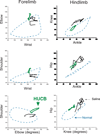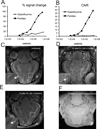Human Umbilical Cord Blood Cells Ameliorate Motor Deficits in Rabbits in a Cerebral Palsy Model
- PMID: 25791742
- PMCID: PMC4908833
- DOI: 10.1159/000374107
Human Umbilical Cord Blood Cells Ameliorate Motor Deficits in Rabbits in a Cerebral Palsy Model
Abstract
Cerebral palsy (CP) has a significant impact on both patients and society, but therapy is limited. Human umbilical cord blood cells (HUCBC), containing various stem and progenitor cells, have been used to treat various brain genetic conditions. In small animal experiments, HUCBC have improved outcomes after hypoxic-ischemic (HI) injury. Clinical trials using HUCBC are underway, testing feasibility, safety and efficacy for neonatal injury as well as CP. We tested HUCBC therapy in a validated rabbit model of CP after acute changes secondary to HI injury had subsided. Following uterine ischemia at 70% gestation, we infused HUCBC into newborn rabbit kits with either mild or severe neurobehavioral changes. Infusion of high-dose HUCBC (5 × 10(6) cells) dramatically altered the natural history of the injury, alleviating the abnormal phenotype including posture, righting reflex, locomotion, tone, and dystonia. Half the high dose showed lesser but still significant improvement. The swimming test, however, showed that joint function did not restore to naïve control function in either group. Tracing HUCBC with either MRI biomarkers or PCR for human DNA found little penetration of HUCBC in the newborn brain in the immediate newborn period, suggesting that the beneficial effects were not due to cellular integration or direct proliferative effects but rather to paracrine signaling. This is the first study to show that HUCBC improve motor performance in a dose-dependent manner, perhaps by improving compensatory repair processes.
© 2015 S. Karger AG, Basel.
Figures






References
-
- Edwards AD, Brocklehurst P, Gunn AJ, Halliday H, Juszczak E, Levene M, Strohm B, Thoresen M, Whitelaw A, Azzopardi D. Neurological outcomes at 18 months of age after moderate hypothermia for perinatal hypoxic ischaemic encephalopathy: Synthesis and meta-analysis of trial data. BMJ. 2010;340:c363. - PMC - PubMed
-
- Gunn AJ, Bennet L. Brain cooling for preterm infants. Clin Perinatol. 2008;35:735–748. vi-vii. - PubMed
-
- Bennet L, Tan S, Van den Heuij L, Derrick M, Groenendaal F, van Bel F, Juul S, Back SA, Northington F, Robertson NJ, Mallard C, Gunn AJ. Cell therapy for neonatal hypoxia-ischemia and cerebral palsy. Ann Neurol. 2012;71:589–600. - PubMed
Publication types
MeSH terms
Grants and funding
LinkOut - more resources
Full Text Sources
Other Literature Sources
Medical
Miscellaneous

